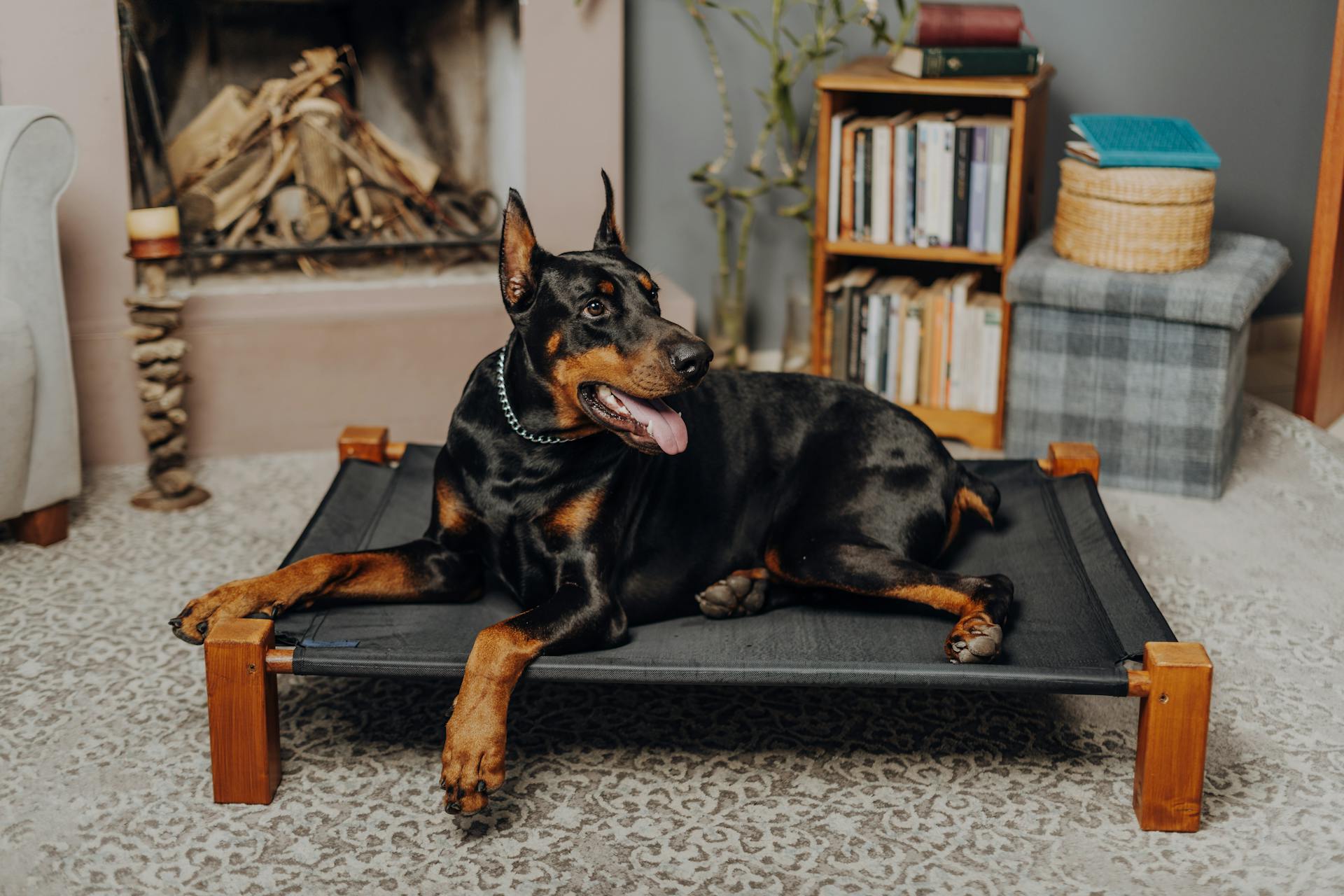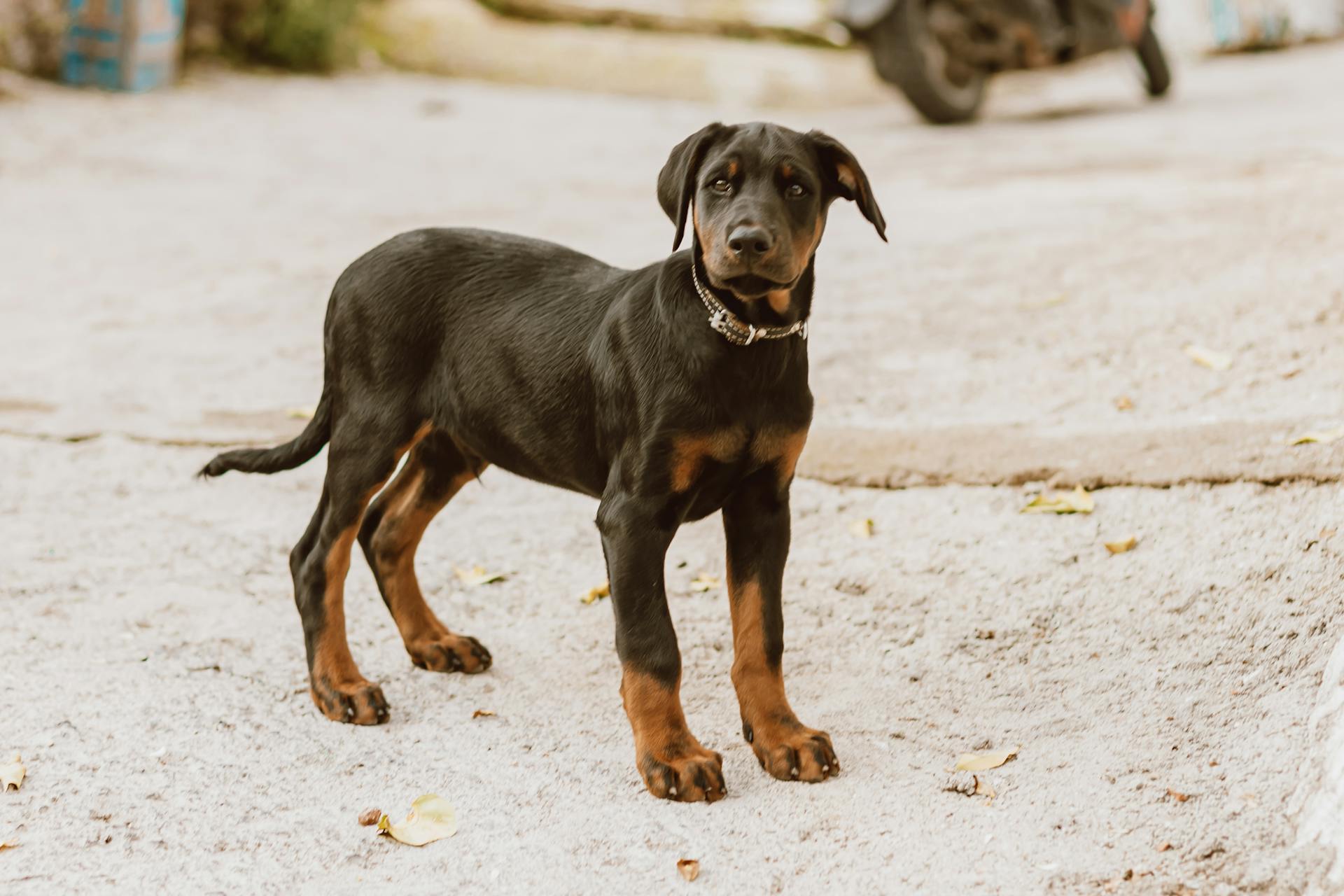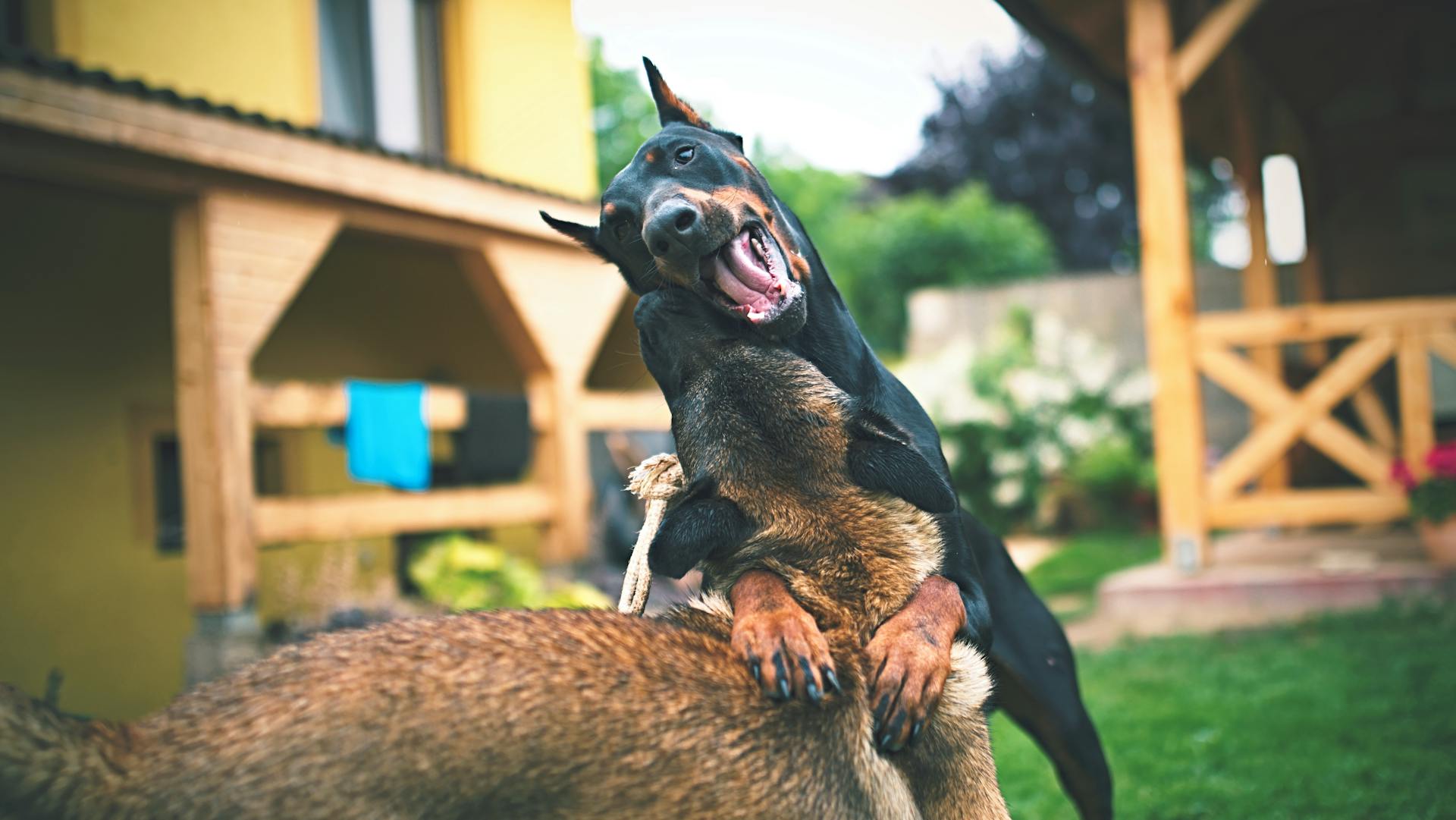
If you're considering bringing a Doberman Pinscher into your family, it's essential to understand their unique needs and characteristics. Doberman Pinschers are a medium to large breed, typically weighing between 60-80 pounds and standing between 24-28 inches tall at the shoulder.
Their short coats require minimal grooming, but regular nail trimming and ear cleaning are necessary to prevent health issues. Doberman Pinschers are also known for their intelligence and loyalty, making them excellent companions for active families.
To ensure a smooth transition for both you and your Doberman Pinscher, it's crucial to establish a consistent training routine from an early age. This will help prevent unwanted behaviors and strengthen your bond with your new pet.
Caring for a Doberman Pinscher
Caring for a Doberman Pinscher requires a lot of energy and attention. They need daily exercise to stay happy and healthy.
Doberman Pinschers are intelligent and curious dogs, so they need mental stimulation too. Engage them in puzzle toys and training sessions to keep their minds active.
Intriguing read: Dog Breeds That Don't Need Grooming
Without consistent exercise, Dobermans can become destructive and develop unwanted behaviors. It's essential to provide them with a structured routine that includes physical and mental activities.
Dobermans are loyal and loving to their families, but they can be wary of new people. Early socialization and training are crucial to help them become confident and friendly.
If you have small animals at home, such as guinea pigs, rabbits, or cats, a Doberman might not be the best fit. Their strong prey drive can make them chase after these pets.
To keep your Doberman safe and happy, make sure to keep them on a leash or inside a fenced area when they're outside. This will prevent them from chasing after neighborhood animals.
A healthy Doberman should have a physical exam performed by a veterinarian at least once a year. Regular check-ups can help identify any potential health issues early on.
Dobermans are prone to dilated cardiomyopathy, a type of heart disease. If you notice symptoms like lethargy, exercise intolerance, coughing, or collapse, seek veterinary care immediately.
Regular veterinary care can help prevent and manage health issues in Dobermans. Set aside a budget of $60 to $100 per month for regular vet visits, medication, and unexpected treatments.
Broaden your view: Doberman Pinscher Diseases
Finding and Preparing for a Doberman Pinscher
Before you bring a Doberman Pinscher into your life, it's essential to consider their needs and whether you're ready to provide the necessary care.
A Doberman Pinscher needs at least 2 hours of exercise per day, which can be a challenge for some owners.
To ensure you're getting a healthy puppy, it's crucial to get your Doberman Pinscher from a reputable breeder.
You'll have the opportunity to check the welfare of the puppies and meet the puppy's mum to see if she has the temperament you're looking for.
Reputable breeders are now required by law to sell puppies directly to buyers, eliminating third-party sellers.
Here are some key things to consider when preparing for a Doberman Pinscher:
Doberman Pinschers are loving companions, but they shouldn't be left alone for long periods of time due to their strong attachment to human company.
On a similar theme: Dogs Breeds That Start with B
Doberman Pinscher Characteristics
Doberman Pinschers are intelligent, loyal, and alert dogs known for their protective nature and strong bond with their families.
They require regular exercise and mental stimulation, making them a great fit for active homes. Exercise needs are high, so be prepared to provide daily physical and mental activity.
Doberman Pinschers have a short, smooth coat that's low maintenance, requiring only regular brushing. They're highly trainable and eager to please, responding well to consistent and positive training methods.
Here are some key characteristics of Doberman Pinschers:
- Origin: Germany
- Size: 60 to 100 pounds (27 to 45 kilograms)
- Lifespan: 10 to 13 years
- Weight: 27 to 45 kilograms
They're prone to certain genetic health issues, such as hip dysplasia and heart conditions, so regular veterinary check-ups are essential to maintaining their health.
If this caught your attention, see: Embark Dog Dna Test Breed & Health Kit Stores
Characteristics
The Doberman Pinscher is a breed that's steeped in history and has a unique set of characteristics that make them a beloved companion for many.
Originating from Germany, Doberman Pinschers are a medium to large breed, weighing between 60 to 100 pounds (27 to 45 kilograms).
Their short, smooth coat is low maintenance, requiring only regular brushing to stay healthy.
Doberman Pinschers are highly intelligent and trainable, making them a great choice for first-time dog owners who are willing to put in the time and effort.
They thrive on mental stimulation and exercise, requiring regular physical activity to keep them happy and healthy.
Doberman Pinschers are known for their protective nature, but they're not typically aggressive unless they feel threatened.
Related reading: When Is the Best Time to Breed Your Dog
Size
Doberman Pinschers have a distinct size pattern based on gender. Males typically stand between 26 to 28 inches tall at the shoulder.
Females are slightly shorter, ranging from 24 to 26 inches in height. This size difference contributes to the characteristic appearance of each gender.
Both males and females fall within the weight range of 60 to 80 pounds, but males tend to be slightly larger and heavier. This weight difference, combined with their athletic build, contributes to the Doberman's overall strength and agility.
Regardless of size, Dobermans are renowned for their intelligence, loyalty, and protective instincts.
Grooming Guide
Owning a Doberman Pinscher is a big responsibility, but with the right care and attention, they can thrive. Doberman Pinschers have a short, smooth coat that sheds moderately, so regular brushing is a must.
You'll want to brush your Doberman's coat at least once a week, using a rubber grooming mitt to remove dead hair more easily. During the spring and autumn, when they tend to shed more, you may need to brush them more frequently.
Doberman Pinschers are prone to ear infections, so regular ear cleanings are essential. Use a veterinarian-recommended cleanser and check for any signs of redness or debris. If you notice any issues, be sure to consult with your vet.
In addition to ear care, nail clipping and regular baths are also necessary. You should budget around $20 to $40 per month for grooming supplies and occasional professional services. Many Doberman owners handle grooming at home, but if you're unsure, it's always best to seek guidance from a vet or groomer.
Here's a quick rundown of the grooming necessities for your Doberman:
- Nail clipping
- Ear cleaning
- Regular baths
Don't forget to check your Doberman's overall health during grooming sessions. Inspect their skin, nose, mouth, eyes, and feet for any signs of sores, rashes, or infection. Clear eyes with no redness or discharge are a good sign of their overall health.
Feeding and Nutrition
Feeding a Doberman Pinscher requires attention to detail to ensure they receive a complete and balanced diet. Feeding commercial kibble or wet food approved by the Association of American Feed Control Officials (AAFCO) is a good way to start.
These dogs need easily digestible protein for healthy muscles, including the heart. Inclusion of omega-3 fatty acids (DHA/EPA) in the diet supports healthy skin, coat, kidneys, and heart.
To reduce the risk of GDV or bloat, feed your Doberman dog two meals per day instead of one larger meal. This is especially important for puppies, who need to eat more frequently, at least three meals every day.
The recommended caloric intake for Doberman Pinschers varies due to different physical sizes, metabolisms, and activity levels. Talk to your veterinarian about how much to feed your Doberman.
Feeding a Doberman Pinscher typically requires providing them with 2.5 to 3.5 cups of high-quality dry food per day, divided into two meals. However, the exact amount of food depends on factors such as the dog's size, age, build, metabolism, and activity level.
To keep your Doberman in good shape, it's recommended to measure their food and feed them twice a day rather than leaving food out all the time. Monitoring their weight is crucial, and you can use the eye and hands-on test to assess if they are at a healthy weight.
Broaden your view: Doberman Pinscher Heart Problems
Dobermans are large dogs and need the right balance of energy, protein, and minerals to ensure healthy joint development. Too much of these nutrients can be as harmful as too little.
Here are some key feeding tips to keep in mind:
- Feed your Doberman two meals per day to reduce the risk of GDV or bloat.
- Measure their food and feed them twice a day to maintain a healthy weight.
- Choose high-quality food that meets your Doberman's nutritional needs.
- Avoid feeding your Doberman immediately before or after exercise to prevent bloating.
Health and Wellness
Owning a Doberman Pinscher comes with its fair share of joys and responsibilities. One of the most important aspects of Doberman ownership is their health and wellness.
Doberman Pinschers are generally a healthy breed, but they can be prone to certain health issues. Their average lifespan is 10-12 years.
Regular veterinary care is crucial for Doberman Pinschers. This includes regular check-ups, vaccinations, and emergency health issues. Monthly, this can translate to setting aside $60 to $100 for regular vet visits, medication, and a contingency for any unexpected treatments.
Some health issues to look out for include Von Willebrand's Disease, Hip Dysplasia, Progressive Retinal Atrophy (PRA), and Hypothyroidism. These conditions can be inherited, so it's essential to work with a reputable breeder who has had their dogs tested for these conditions.
Here are some common health issues to watch out for in Doberman Pinschers:
- Von Willebrand's Disease: causes excessive bleeding after injury or surgery
- Hip Dysplasia: a hereditary condition where the thighbone doesn't fit properly into the hip joint
- Progressive Retinal Atrophy (PRA): a group of eye diseases causing gradual retina deterioration
- Hypothyroidism: a thyroid disorder linked to epilepsy, hair loss, obesity, and skin conditions
In addition to regular veterinary care, it's also essential to keep an eye out for any changes in your Doberman's behavior or physical condition. If you notice any redness, discharge, or cloudiness in their eyes, contact your vet immediately.
Exercise and Training
Exercise and training are crucial for Doberman Pinschers, given their size and strength. Training can range from $100 to $200 a month, whether through obedience classes or personalized training sessions.
Socialization is equally important to ensure your Doberman is well-behaved around other dogs and people. Professional socialization services can add to the cost, but it's essential for their well-being.
You can engage your Doberman in fun activities like agility, nose work, tracking, and obedience training to keep them active and mentally stimulated. These activities can be a great way to bond with your dog and provide exercise.
Here are some fun activities for Doberman Pinschers:
- Agility
- Nose work
- Tracking
- Obedience training
Training
Training is crucial for Dobermans, given their size and strength, and can range from $100 to $200 a month. Obedience classes or personalized training sessions are essential to ensure they behave well around other dogs and people.
Dobermans are intelligent and respond well to early socialization, which can help them become fun and loving family dogs. With proper training, they can learn to be patient with young children and even live with cats if introduced properly.
If you're planning to get started in dog sports, there are various options to consider, including obedience classes, agility training, and even virtual dog sports and events. You can find more information on dog sports and training resources in the section "GETTING STARTED IN DOG SPORTS".
Doberman owners should be aware of their strong prey drive, which may lead to chasing small animals. However, with proper training and socialization, this can be managed.
Here's a quick rundown of some dog sports and training resources:
- Intro to Dog Sports
- Canine Partners / Enroll Mixed Breed
- Titles & Abbreviations
- Which Sport Should You Do With Your Dog?
- Get Started in Dog Training
- Virtual Dog Sports & Events
Exercise Needs
Exercise needs for Doberman Pinschers are quite specific. They require a mix of physical and mental stimulation to stay healthy and happy.
For physical exercise, agility training is a great option. It's a fun way to keep your Doberman active and engaged.
Dobermans also excel at nose work and tracking activities. These exercises challenge their sense of smell and problem-solving skills.
In addition to physical exercise, obedience training is essential. It helps strengthen the bond between you and your Doberman, while also teaching them important life skills.
To ensure your Doberman gets the mental stimulation they need, consider allocating $15 to $30 per month for durable toys and entertainment. This will help keep them engaged and prevent boredom.
Here are some fun exercise ideas for Doberman Pinschers:
- Agility
- Nose work
- Tracking
- Obedience training
Breed Information
Doberman Pinschers are a relatively small breed, weighing between 60-80 pounds and standing 24-28 inches tall at the shoulder.
They have a short, smooth coat that requires minimal grooming and comes in a variety of colors, including black, red, blue, and fawn.
On average, Doberman Pinschers live between 10-12 years, but with proper care and attention, some have been known to live up to 14 years.
History
The Doberman Pinscher has a rich history that spans over a century. It all began in the late 19th century in Apolda, Thuringia, Germany, where a tax collector named Louis Doberman sought protection during his rounds.
Louis Doberman was the town's dogcatcher, and he began breeding dogs to create a loyal companion and protector. The specific breeds used in the mix remain uncertain, but speculation includes the Rottweiler, German Pinscher, and Black and Tan Terrier.
The Doberman Pinscher made its first appearance in 1876 and received a warm reception. The breed was initially developed to be a highly capable "super dog", prioritizing functionality over appearance.
In 1900, the German Kennel Club officially recognized the Doberman Pinscher as a distinct breed. This marked a significant milestone in the breed's development.
A breeder named Otto Goeller played a crucial role in shaping the Doberman into a more trainable and practical dog. His efforts helped to balance the breed's reputation for being headstrong and aggressive.
The Doberman Pinscher made its way to the United States around 1908, where it quickly gained popularity. One of the first Dobermans shown in conformation reportedly won "Best in Show" honors at three consecutive events.
The Doberman Pinscher Club of America was established in 1921, adopting the breed standard written in Germany a year later. This ensured that the breed's development continued on a consistent path.
Economic difficulties during World War I caused a decline in the Doberman's population in Europe, but breeding was restricted to the very best dogs, mainly owned by the military, police, and wealthy individuals. This led to a significant improvement in the breed's quality.
With the outbreak of World War II, the Doberman Pinscher was again in peril in Germany, but due to earlier importations, the breed had already been secured in the United States.
A fresh viewpoint: Show Me the Largest Dog in the World
German
The German breed, such as the Doberman Pinscher, is highly intelligent and thrives in obedience and basic dog training.
Providing a consistent training and socialization routine early in life is crucial to encourage good behavior and redirect undesired behaviors in these breeds.
Without positive reinforcement training, German breeds like the Doberman Pinscher can become pushy and unmanageable, as well as reactive to novel stimuli.
A well-structured training routine can help your German breed grow into a well-adjusted canine citizen.
Take a look at this: Welsh Corgi Training
Breed Organizations
When you're considering bringing a Doberman Pinscher into your life, it's essential to find a reputable breeder. Reputable breeders are committed to breeding healthy, well-socialized puppies that will make great companions.
Reputable breeders screen their breeding stock for health problems and socialize their puppies from a young age. This ensures that the puppies are less likely to have health and behavioral issues.
If you're looking for a Doberman Pinscher, it's worth noting that puppies from backyard breeders are more likely to have both health and behavioral issues. Backyard breeders are more interested in making a profit than in producing healthy, well-adjusted dogs.
Here are some breed clubs, organizations, and associations that provide valuable information about the Doberman:
- Doberman Pinscher Club of America (DPCA)
Frequently Asked Questions
What is the downside to Dobermans?
Dobermans can be challenging for first-time owners due to their demanding nature and need for serious attention. They require a dedicated owner who can provide consistent care and interaction.
Are Doberman Pinscher good house dogs?
Yes, Doberman Pinschers can make good house dogs for families with proper socialization, but they often form strong bonds with one person. With early socialization and training, they can be loyal and loving companions.
Featured Images: pexels.com

